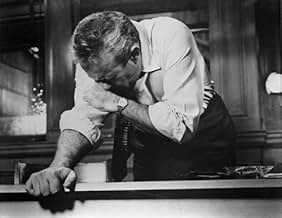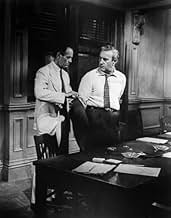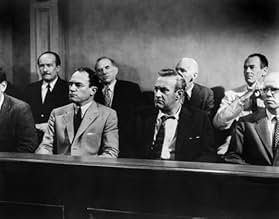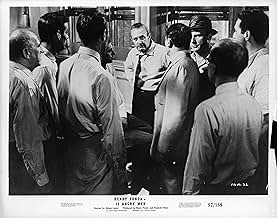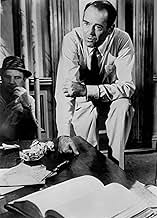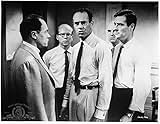The jury in a New York City murder trial is frustrated by a single member whose skeptical caution forces them to more carefully consider the evidence before jumping to a hasty verdict.The jury in a New York City murder trial is frustrated by a single member whose skeptical caution forces them to more carefully consider the evidence before jumping to a hasty verdict.The jury in a New York City murder trial is frustrated by a single member whose skeptical caution forces them to more carefully consider the evidence before jumping to a hasty verdict.
- Nominated for 3 Oscars
- 16 wins & 12 nominations total
- Stenographer
- (uncredited)
- Guard
- (uncredited)
- Court Clerk
- (uncredited)
- The Accused
- (uncredited)
- Man Waiting for Elevator
- (uncredited)
Summary
Featured reviews
The acting is top notch. I believe that monologue acting is quite a bit simpler than real reactive ensemble acting. Most of what we see today is monologues pretending to be conversations. But in this film, we have utter mastery of throwing emotions. Once the air becomes filled with human essence, it is hard to not get soaked ourselves as the camera moves through the thick atmosphere. Yes, there are slight differences in how each actor projects (Fonda internally, Balsam completely on his skin...) but the ensemble presents one vision to the audience.
The writing is snappy too. You can tell it was worked and worked and worried, going through several generations. It is easy to be mesmerized by this writing and acting, and miss the rare accomplishment of the camera-work. This camera is so fluid, you forget you are in one room. It moves from being a human observer, to being omniscient, to being a target. It is smart enough to seldom center on the element of most importance, so expands the field to all men.
This is very hard. Very hard, to make the camera human. So much easier to do what we see today -- acknowledge the machinery and jigger with it. Do we have a filmmaker today who could do this?
Ted's Evaluation -- 4 of 3: Every cineliterate person should experience this.
The tension of the characters draws the audience in from the start. We imagine that the case is open and shut, 11 me saying guilty and 1 not. We feel the discomfort of Henry Fonda as the other characters belittle and mock how he can see any reasonable doubt in the case. But we also share his victories and the enthusiasm as he proceeds to refute or add doubt to the arguments for guilty and are captivated and draw in as other jurors begin to see doubt in the proceedings.
The audience can also see the arguments for guilty and wonder if Fonda's character is correct in saying that he doubts. Yet they also feel the shame of the characters as he disproves that a previously sound theory is iron tight, joining his side as members of the jury do.
On top of this they are wonderfully woven in human elements such as the misconceptions that influence people and the growing tension between different characters. This is brought to life even more by the amazing performances, Fonda, Lee J Cobb and Joseph Sweeney are of particular note.
I started watching this film on a bored relaxed laying about day but by the end i was on the edge of the seat with my hands on my knees feeling more tense than a politician on results day.
How a film should be made. Modern directors take note(thats ur telling off for the day) 10/10
Did you know
- TriviaDirector Sidney Lumet had the actors all stay in the same room for several hours on end and do their lines over and over without filming them. This was to give them a real taste of what it would be like to be cooped up in a room with the same people.
- GoofsWithin the last half hour of the movie, the clock on the wall in the jury room can be seen indicating 6:15. Several minutes later, E.G. Marshall states that it is "a quarter after six". Several minutes after that, the wall clock is seen again, but still shows 6:15. Still later, when Lee J. Cobb leans over the table after he tears up the snapshot from his wallet, his watch can be seen indicating 5:10.
- Quotes
Juror #8: Let me ask you this: Do you really think the boy'd shout out a thing like that so the whole neighborhood could hear him? I don't think so - he's much too bright for that.
Juror #10: Bright? He's a common ignorant slob. He don't even speak good English.
Juror #11: [who has a foreign accent] He *doesn't* speak good English.
- Crazy creditsAt the end of the film, the actors are billed in order of their juror numbers; thus Henry Fonda, although the star of the film, appears 8th.
- Alternate versionsThe United Artists logo is plastered with black and white versions of the MGM/UA Communications Co./1987 United Artists logo in the 1990 VHS, and 1994 variant in the DVD. But in the 2008 DVD and some TV prints, it featured the colorized opening and closing MGM logos.
- ConnectionsEdited into Voskovec & Werich - paralelní osudy (2012)
Details
Box office
- Budget
- $350,000 (estimated)
- Gross worldwide
- $2,945
- Runtime
- 1h 36m(96 min)
- Color
- Sound mix
- Aspect ratio
- 1.85 : 1




